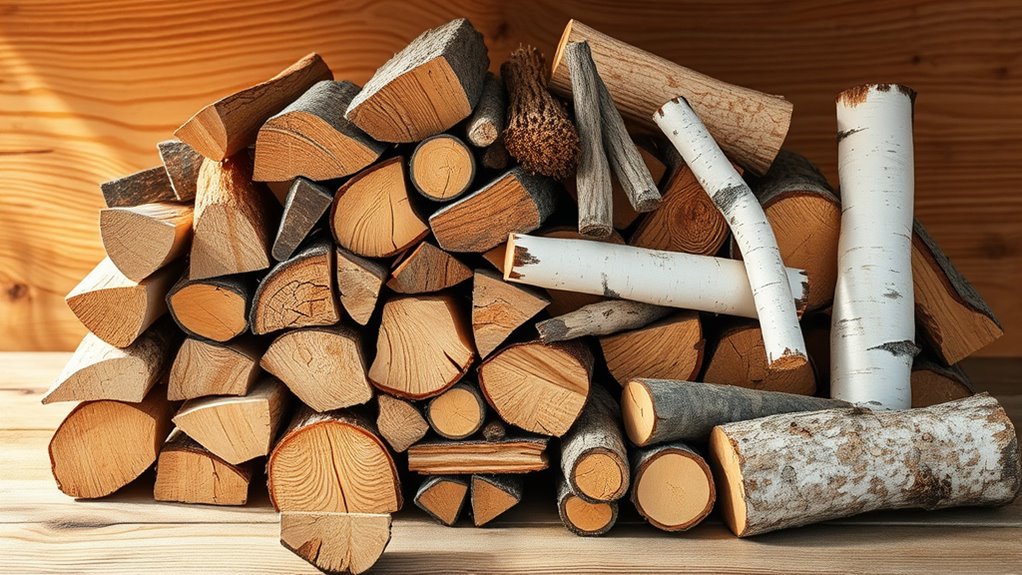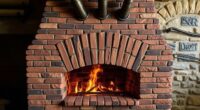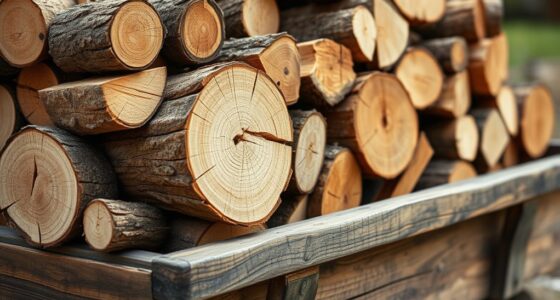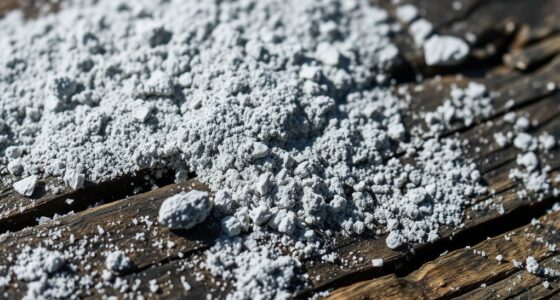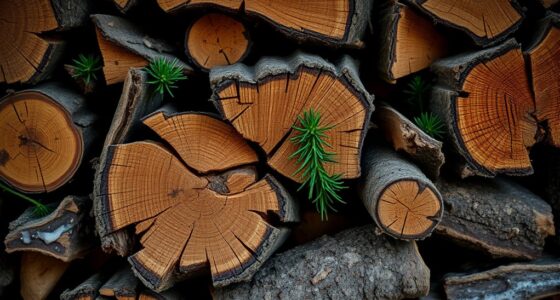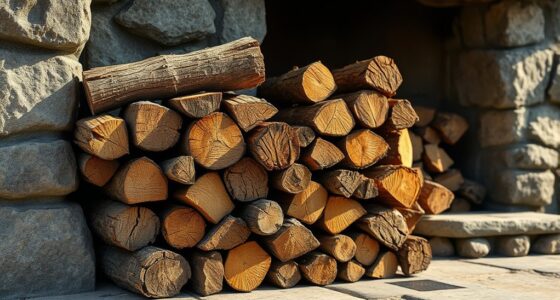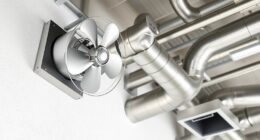For the best results, choose dense hardwoods like oak, hickory, or maple, as they burn longer and produce more heat. Properly season your firewood by splitting, stacking in a dry, ventilated area, and checking that the moisture content is below 20%. Avoid green or wet wood to prevent smoke and creosote buildup. To learn more about selecting and preparing your firewood for safe, efficient fires, keep exploring these essential tips.
Key Takeaways
- Opt for dense hardwoods like oak, hickory, and maple for longer-lasting, efficient fires with steady heat output.
- Season firewood by splitting, stacking in a dry, ventilated area, and waiting 6-12 months until moisture drops below 20%.
- Use a moisture meter to ensure firewood has less than 20% moisture for cleaner, hotter burns and reduced creosote buildup.
- Properly store firewood off the ground, covered on top but open on sides, to allow air circulation and prevent moisture absorption.
- Avoid burning green or wet wood; always select well-seasoned, dry wood for safety, efficiency, and environmental benefits.
Hardwoods vs. Softwoods: Which Is Better for Your Stove?
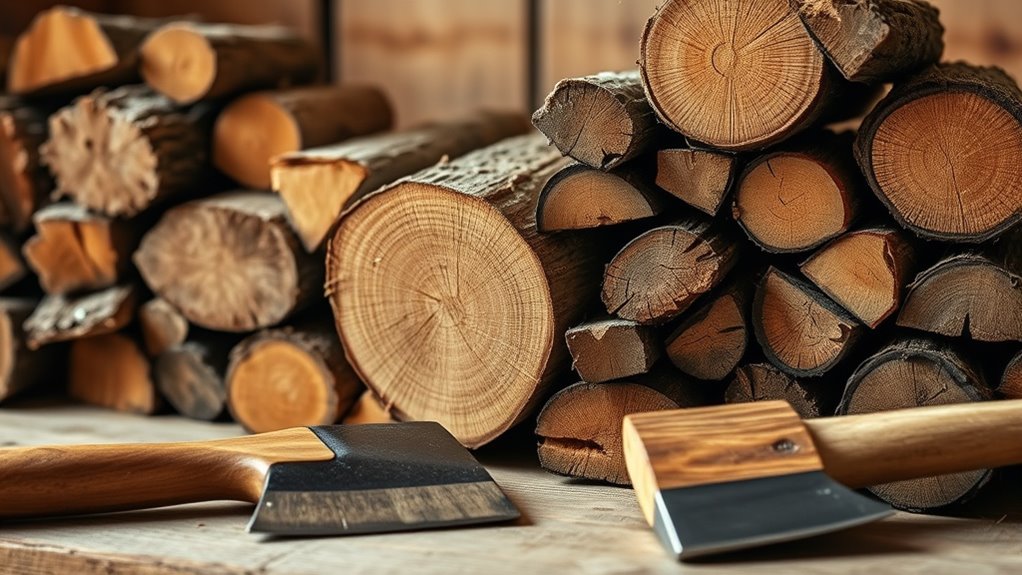
When choosing firewood for your stove, understanding the difference between hardwoods and softwoods is essential. Firewood density plays a key role—hardwoods are generally denser, meaning they contain more energy per log and burn longer. Softwoods are less dense, igniting quickly but burning faster. Accurate moisture measurement is vital regardless of type; wet wood produces more creosote and burns inefficiently. Properly seasoned hardwoods typically have a moisture content below 20%, ensuring a hotter, cleaner burn. Softwoods can also be seasoned, but they tend to have higher moisture levels initially. Knowing the firewood density helps you select logs that are easier to light, produce more heat, and generate less smoke, making your stove operation more efficient and safer. Additionally, using renewable wood fuel supports sustainable forestry and reduces environmental impact, which is an important environmental benefit to consider. To optimize your wood stove, consider the moisture content of your logs, as it directly impacts combustion efficiency and emissions. Ensuring proper airflow during burning also enhances efficiency and reduces smoke production. Recognizing the density of different firewood types can guide you in choosing the best logs for your heating needs.
Top Hardwood Choices for Efficient Burning
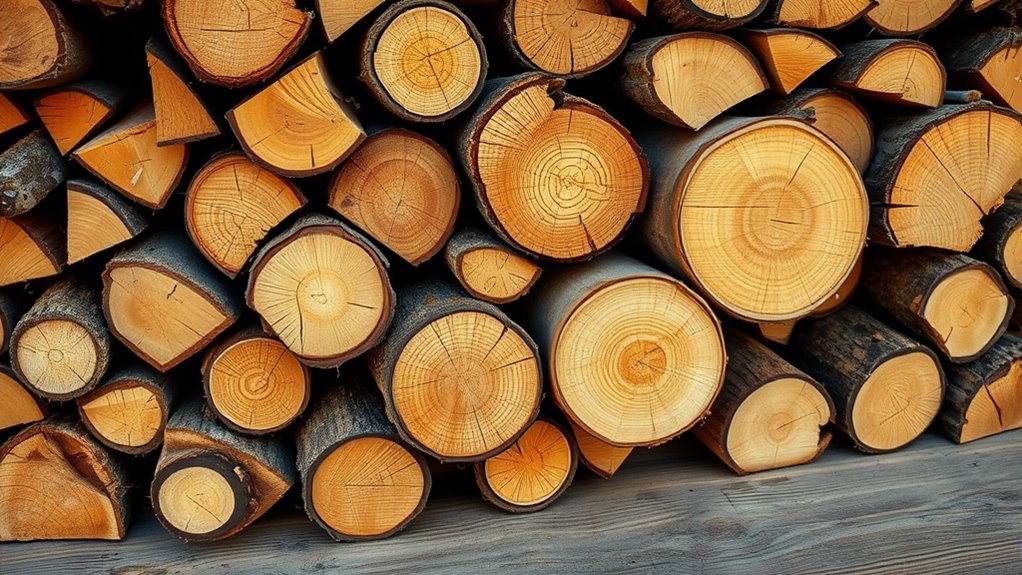
Choosing the right hardwood can make your fire burn longer and more efficiently. Look for options with low moisture content to maximize heat and reduce smoke. Popular hardwood varieties like oak, hickory, and maple are excellent choices for consistent, lasting fires. Incorporating seasoned, high-fiber wood can further enhance combustion efficiency and heat output. Additionally, selecting properly dried wood ensures optimal burning performance and minimizes creosote buildup in your stove. Knowing the moisture content of your firewood is essential for achieving a cleaner and more efficient burn. Properly stored firewood also benefits from seasoning, which reduces moisture levels and improves overall combustion. Using sound design techniques to analyze and optimize your firewood choice can help you achieve the most efficient and safe burn possible.
Dense, Long-Lasting Burn
Hardwoods are your best option for dense, long-lasting burns because they pack more energy into each piece. These woods burn slowly, giving off a steady heat and a pleasant firewood aroma that enhances your cozy experience. When choosing seasonal firewood, look for dense hardwoods like oak, hickory, or maple, which are known for their durability and extended burn times. Their high density means you’ll need fewer logs but enjoy more consistent heat over hours. This efficiency makes them ideal for maintaining a warm home without frequent refueling. Plus, their long-lasting burn ensures your stove stays active longer, reducing wood consumption. Selecting the appropriate firewood storage method helps keep your hardwoods dry and ready for optimal burning. Opting for the right dense hardwoods guarantees a reliable, efficient fire that keeps your space warm and inviting for hours on end.
Low Moisture Content
Using firewood with low moisture content is essential for efficient burning and maximum heat output. When your wood’s moisture levels are too high, it produces more smoke, creosote, and less heat. To make certain your firewood is properly seasoned, focus on effective seasoning techniques, such as splitting wood into smaller pieces and storing it in a dry, ventilated area. Properly seasoned firewood typically has moisture levels below 20%, which helps it ignite easily and burn more completely. Always check the moisture content with a moisture meter if possible. Well-seasoned hardwoods like oak, hickory, and maple are excellent choices because they tend to dry faster and burn cleaner when properly seasoned. Additionally, using wood with low moisture content reduces the risk of creosote buildup in your chimney, enhancing safety and efficiency. Using low-moisture firewood guarantees a hotter, more efficient fire with less creosote buildup and better combustion efficiency. Incorporating proper drying techniques can further improve the quality of your firewood, ensuring optimal performance.
Popular Hardwood Varieties
Among the best hardwoods for efficient burning are oak, hickory, and maple, which are renowned for their dense, slow-burning qualities. Their high wood density means they burn longer and produce more heat per log, making them ideal for sustained fires. Tree species substantially influence firewood performance, as different varieties vary in density and burn rate. When selecting hardwoods, consider these popular choices:
- Oak: Exceptionally dense, provides steady, long-lasting heat
- Hickory: Known for high energy content and aromatic smoke
- Maple: Burns evenly with good heat output
- Beech: Dense, burns slow with minimal sparks
- Ash: Slightly less dense but ignites easily and burns clean
Choosing the right tree species ensures efficient, reliable heating for your stove. Additionally, proper firewood preparation, such as seasoning and splitting, enhances burning efficiency and safety.
Softwoods to Use With Caution and When They’Re Suitable

While softwoods can be convenient and cost-effective, they should be used with caution for burning purposes. Some types to avoid include pine, spruce, and cedar, especially if they haven’t been properly seasoned. Softwood hazards include excessive creosote buildup, which increases the risk of chimney fires, and quicker burning that produces less heat over time. However, softwoods are suitable for kindling or quick, short-term fires due to their high resin content, which ignites easily. Use softwoods sparingly and always ensure they’re well-seasoned to minimize hazards. Additionally, understanding symptoms of unsafe burning, such as excessive smoke or creosote buildup, can help prevent potential hazards. Proper firewood storage is also crucial to ensure softwoods dry adequately before use. Ensuring proper seasoning techniques can significantly reduce the risks associated with softwood burning. Keep in mind that fire safety practices are essential when using any type of wood to prevent accidents and ensure efficient burning. Avoid relying solely on softwoods for sustained heating, but they can be useful in specific situations when handled carefully. Always prioritize hardwoods for long-lasting, efficient fires when possible.
How to Properly Season and Dry Your Firewood
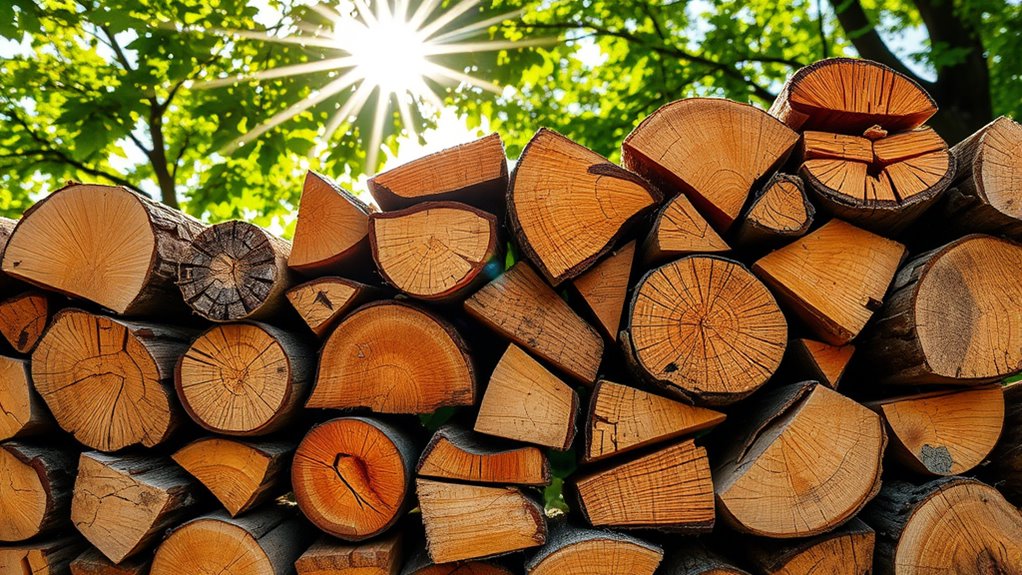
Properly seasoning and drying your firewood is essential for safe, efficient burning. Well-seasoned firewood produces less smoke, creosote, and harmful emissions, and burns hotter. To achieve this, stack your wood in a dry, ventilated area, off the ground, and cover the top to protect from rain but allow airflow. Use firewood certifications to ensure quality and avoid treated or contaminated wood. Incorporate natural aromatics and additives, like herbs or dried bark, to enhance aroma and improve burning properties. Proper drying usually takes 6-12 months, depending on moisture content. Regularly check the wood’s moisture level with a moisture meter. Proper seasoning not only improves burn quality but also extends the lifespan of your stove and chimney. Well-seasoned wood ignites quickly, burns cleanly, and maximizes your stove’s efficiency. Additionally, understanding the moisture content of your firewood can help you determine when it is optimally dried and ready to burn. Testing your wood with a moisture meter ensures precise measurement of its dryness level, leading to better burning results. Proper prep makes all the difference in enjoying a safe, warm fire, and understanding the paranormal aspects of natural materials can add an intriguing layer to your fireplace rituals.
Best Practices for Storing Firewood to Ensure Quality

To keep your firewood burning well, you need to store it properly. Using the right drying methods and maintaining ideal storage conditions help preserve its quality. Follow these practices to guarantee your firewood stays dry, seasoned, and ready to use. Additionally, stacking firewood properly improves airflow, which is essential for effective drying and seasoning.
Proper Drying Methods
Ensuring your firewood is properly dried is essential for efficient burning and safety. Proper drying methods help control moisture levels, which improves combustion and reduces creosote buildup. To achieve ideal moisture control, use effective drying techniques like stacking wood off the ground, ensuring good airflow, and covering the top to protect from rain while leaving sides open. Regularly check moisture content with a moisture meter, and allow ample drying time—typically six months to a year. Properly dried firewood produces more heat, burns cleaner, and minimizes smoke. Remember, well-dried wood ignites faster and lasts longer. Mastering these drying techniques ensures your firewood is ready, safe, and efficient for winter fires. Additionally, understanding the best home theatre projectors can enhance your overall experience when relaxing by the fire. Proper storage also involves seasoned wood, which is crucial for optimal burning.
Optimal Storage Conditions
Storing firewood correctly is essential for maintaining its quality and readiness for use. To do this, focus on humidity control and pest prevention. Keep wood in a well-ventilated, dry area, ideally off the ground. Cover the top, but leave sides open to allow airflow and prevent moisture buildup. Use the following table as a visual guide:
| Storage Condition | Key Benefit | Best Practice |
|---|---|---|
| Elevated Shelf | Humidity regulation | Store on pallets or racks |
| Covered Top | Pest prevention | Use a breathable cover |
| Open Sides | Air circulation | Ensure airflow around stacks |
This setup reduces mold, keeps pests away, and preserves the wood’s quality for efficient burning.
Preparing Firewood: Cutting, Splitting, and Handling Tips
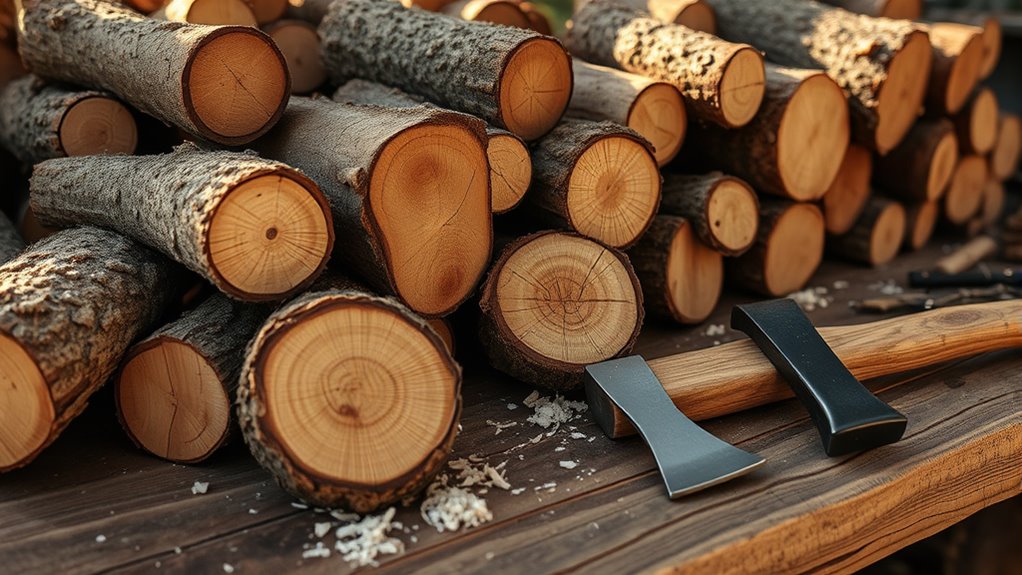
Preparing firewood properly starts with effective cutting, splitting, and handling techniques that make your wood burn better and last longer. Use sharp tools to guarantee clean cuts, which help with firewood seasoning. When splitting, employ proper splitting techniques—aim for straight-grained wood and avoid knots for easier handling. Always lift with your legs, not your back, to prevent injury. Stack the split firewood in a dry, well-ventilated area to promote seasoning and reduce moisture. Keep smaller pieces for quicker ignition and larger logs for sustained heat. By mastering these techniques, you’ll produce firewood that burns efficiently and produces less creosote buildup.
Proper firewood preparation ensures efficient burning, longer-lasting logs, and less creosote buildup.
- Use proper tools for clean cuts
- Split along the grain for easier handling
- Stack in a sunny, ventilated spot
- Wear safety gear during splitting
- Store firewood off the ground
Recognizing Well-Seasoned Firewood and Its Benefits

You can tell firewood is well-seasoned by its color and texture—dull, grayish tones and cracks indicate dryness. Moisture content is essential, so if the wood feels lightweight and produces less smoke, it’s ready to burn. When you light it, expect steady flames and minimal popping, showing it’s properly seasoned and burns efficiently.
Color and Texture Clues
Recognizing well-seasoned firewood often comes down to its color and texture. Color cues reveal a dull, grayish hue rather than a bright or fresh appearance, indicating it’s been properly dried. Texture hints show that seasoned wood feels dry and slightly rough, not soft or spongy. You should notice cracks or splits at the ends, a sign of moisture loss. Well-seasoned wood typically has a consistent surface with fewer wet spots or shiny patches. Its weight feels lighter compared to freshly cut logs. When examining your firewood, look for these visual and tactile clues to ensure you’re using the best, most efficient fuel. Properly seasoned wood burns cleaner, produces more heat, and reduces creosote buildup in your chimney.
- Grayish, faded color
- Dry, rough surface
- Visible cracks or splits
- Light weight
- No shiny or wet patches
Moisture Content Indicators
How can you tell if firewood is truly well-seasoned? One way is by using moisture meters, which give an accurate reading of the wood’s moisture content—ideally below 20%. Well-seasoned firewood usually shows visible signs such as minimal wood cracking and a darker, dry appearance. When you split seasoned wood, it should produce a sharp cracking sound rather than a dull thud. If the wood feels heavy and retains moisture, it’s likely green or unseasoned. You can also check for a dry, hollow sound when knocking two pieces together. Using moisture meters and paying attention to wood cracking are reliable indicators that your firewood has been properly dried and will burn efficiently.
Burning Performance Signs
When firewood is properly seasoned, its burning performance noticeably improves. Well-seasoned firewood burns hotter, produces less smoke, and creates more heat with less effort. Recognizing these signs guarantees you’re getting the most out of your firewood. To confirm, perform moisture testing—firewood with less than 20% moisture content typically burns best. Look for the following signs of good firewood seasoning:
- Cracks or splits in the wood
- A dull, dry surface
- Light weight compared to green wood
- No visible moisture or mold
- Clear, sharp sound when tapped
These indicators help you identify well-seasoned firewood, leading to more efficient burns and less creosote buildup. Properly seasoned wood is essential for safety, heat, and ease of use.
Common Mistakes to Avoid When Selecting Firewood

Choosing the wrong type of firewood can lead to poor burning, excessive smoke, and creosote buildup, which can damage your fireplace or chimney. One common mistake is neglecting firewood moisture; wet or green wood burns inefficiently and produces more smoke. Always select seasoned firewood with low moisture content. Additionally, improper wood storage tips can cause wood to remain damp or develop mold. Avoid storing wood on the ground or in humid areas. Instead, stack it in a dry, well-ventilated space. Here’s a quick guide:
| Mistake | Solution | Result |
|---|---|---|
| Choosing green or wet wood | Use seasoned, dry firewood | Cleaner, efficient burn |
| Poor wood storage | Store in a dry, ventilated area | Less moisture and mold |
| Ignoring firewood moisture | Check moisture content before buying | Better combustion |
Enhancing Burn Efficiency Through Proper Firewood Prep
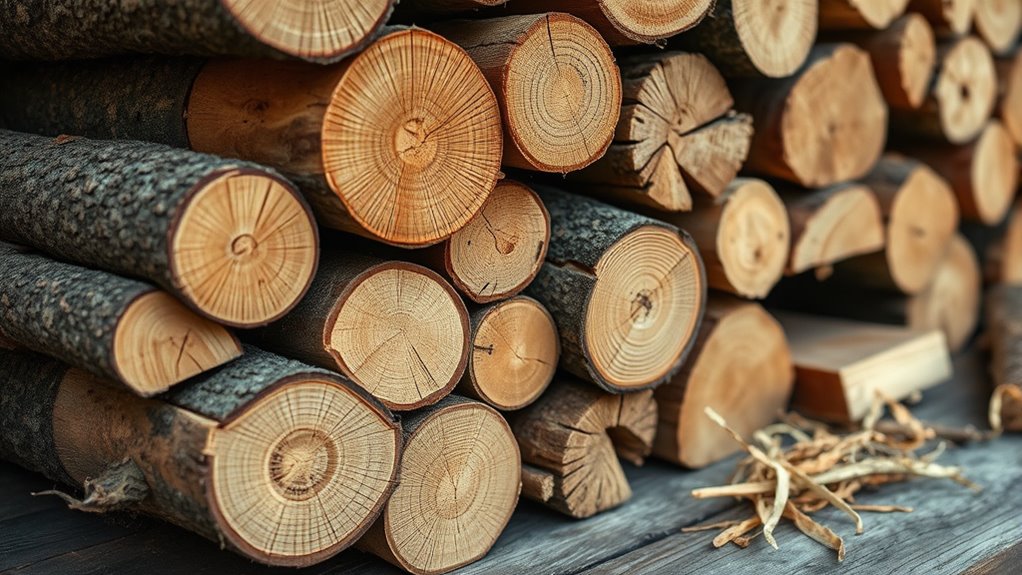
Proper firewood preparation is essential for maximizing burn efficiency and ensuring a safer, cleaner fire. To achieve this, start with seasoned logs that have been dried properly, reducing moisture content. Use moisture meters to check that your wood has less than 20% moisture, which promotes complete combustion. Stacking logs correctly improves airflow and speeds up drying. Split larger logs into smaller pieces for faster drying and easier ignition. Store your firewood in a dry, ventilated location off the ground to prevent moisture absorption. Properly prepared firewood burns hotter, longer, and with less creosote buildup, making your stove more efficient and safer for your home.
Safety Tips for Handling and Storing Firewood
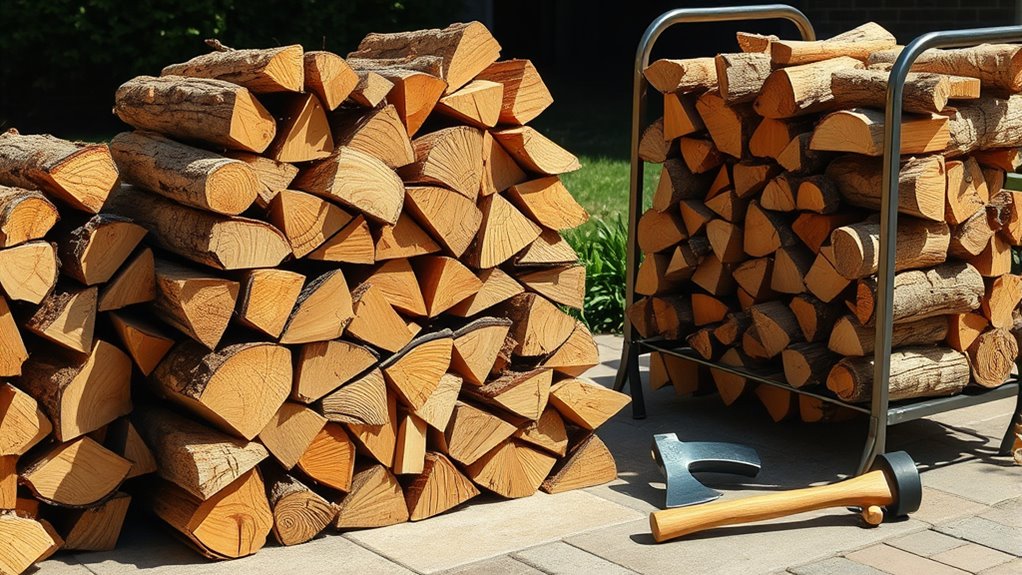
Handling and storing firewood safely is vital to prevent accidents and maintain its quality. Always wear gloves to protect your hands from splinters and dirt. Stack firewood on a stable, raised surface away from your home to reduce pest intrusion and moisture absorption. Keep wood dry and covered, but guarantee airflow for proper drying. Regular chimney maintenance is essential; creosote buildup can pose fire hazards, so schedule inspections and cleanings. Store fire safety equipment nearby, like fire extinguishers and smoke detectors, for quick response if needed. Avoid overloading your stove or chimney, and never burn wet or green wood. By following these safety tips, you’ll protect your home and ensure safe, efficient heating all winter.
Frequently Asked Questions
How Can I Tell if Firewood Is Properly Seasoned?
To tell if firewood is properly seasoned, look for seasoning indicators like cracks in the wood and a dull, dry appearance. You can also perform moisture testing by using a moisture meter—ideally, the moisture content should be below 20%. Well-seasoned wood feels lighter, burns more efficiently, and produces less smoke. If it’s heavy and damp, it needs more time to season before use.
What Are the Environmental Impacts of Different Firewood Types?
You might wonder about the environmental impacts of different firewood types. By choosing sustainably harvested wood, you reduce your carbon footprint and support forest health. Hardwoods often burn longer, producing less smoke, while softwoods may release more emissions. Opting for locally sourced wood minimizes transportation emissions. Overall, your choices impact air quality and ecosystems, so prioritize sustainably harvested, well-seasoned firewood to lessen environmental harm.
Can I Burn Treated or Painted Wood in My Stove?
You shouldn’t burn treated or painted wood in your stove because of the hazards involved. Treated wood releases toxic chemicals, and burning it can emit harmful fumes into your home and environment. Painted wood toxicity is also a concern, as the paint may contain lead or other dangerous substances that become airborne when burned. Always stick to plain, dry firewood to guarantee safe and clean burning.
How Does Firewood Moisture Content Affect Stove Efficiency?
Moisture content directly impacts your stove’s burn efficiency. If your firewood has high moisture, it burns slowly, produces more smoke, and wastes heat. Ideally, you want wood with around 20% moisture or less for peak burn. Well-seasoned wood heats your space better, reduces creosote buildup, and saves you money. So, always check moisture content before burning to guarantee a cleaner, more efficient fire.
Are There Specific Firewood Types Recommended for Indoor Versus Outdoor Fireplaces?
Kicking off with the right choice is key. For indoor fireplaces, opt for seasoned hardwoods like oak or maple, stored properly to keep moisture out. Outdoor fires can handle softer woods such as pine, which ignite easily. Use proper firewood storage to prevent moisture buildup, and employ effective wood splitting techniques for safety and efficiency. This way, you’ll have the best firewood ready for any setting, ensuring a cozy and safe experience.
Conclusion
Choosing the right firewood is like tending a well-tuned orchestra—you want the harmony of warmth and safety. By selecting seasoned hardwoods, avoiding softwoods, and storing properly, you guarantee a cozy, efficient fire that lights up your home without chaos. Think of your firewood as a trusted partner in your winter symphony—prepared, seasoned, and ready to perform, bringing comfort and safety with every crackle and glow.

